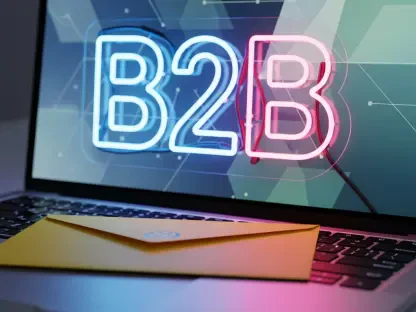In today’s digital marketplace, where a single search can significantly influence consumer behavior, a notable discrepancy between Google AI and ChatGPT is creating a storm for businesses as these two tech titans, armed with cutting-edge AI, often fail to agree on something as basic as recommending a brand for headphones or skincare. This clash isn’t just a tech oddity—it’s a battleground that’s reshaping how brands fight for visibility in an era dominated by generative search.
Why AI Titans Disagree on Brand Spotlights
The world of AI-driven search is a labyrinth of algorithms, and even giants like Google AI and ChatGPT often point users in wildly different directions. A staggering 61.9% of identical prompts yield contrasting brand mentions across these platforms, leaving only a slim 17% of queries with any consensus. This isn’t a minor glitch; it’s a fundamental divide in how these systems interpret data and prioritize recommendations, impacting everything from small startups to global corporations.
Diving deeper, Google AI Overviews stands out by mentioning brands in 36.8% of queries, far outpacing ChatGPT’s meager 3.9%. The numbers paint a stark contrast—Google’s system averages 6.02 brands per response, while ChatGPT hovers at just 2.37. This gap highlights a critical divergence in approach, where one platform amplifies visibility and the other remains curiously restrained, creating confusion for users seeking reliable advice.
The implications ripple beyond mere search results. For marketers, this inconsistency is a double-edged sword—while it reveals the unpredictable nature of AI recommendations, it also underscores the urgent need to understand each platform’s quirks. Businesses that fail to adapt risk fading into digital obscurity, as the battle for attention intensifies in this fragmented landscape.
The High Stakes of AI’s Brand Inconsistency
In a world where AI tools increasingly dictate consumer choices, the lack of alignment between Google AI and ChatGPT poses a serious challenge for brands. These platforms act as gatekeepers, influencing purchasing decisions on a massive scale, yet their conflicting outputs create a volatile environment. Marketers now face a reality where a brand might dominate one system’s results but vanish entirely from another’s, disrupting carefully crafted strategies.
This unpredictability hits hard in terms of market share and visibility. For instance, a company pouring resources into optimizing for Google AI Overviews might see significant returns with frequent mentions, only to be sidelined by ChatGPT’s selective silence—evident in its 43.4% rate of avoiding brand mentions. Such disparities force businesses to rethink how they allocate budgets and measure success in a space where no single rule applies.
Beyond financial impacts, this issue erodes trust in AI as a reliable guide for consumers. When recommendations vary so drastically, users may question the credibility of these tools, potentially driving them back to traditional search methods or peer reviews. For brands, navigating this uncertainty is no longer optional—it’s a survival tactic in a digital ecosystem that refuses to play by consistent rules.
Unpacking the Data Behind the Divide
A closer look at the numbers reveals just how fractured the AI search landscape has become. Google AI Overviews not only mentions more brands but also emphasizes transparency, with citations outnumbering brand mentions at 14.30 to 6.02 per query. In stark contrast, ChatGPT often skips sourcing, showing 3.2 times more mentions (2.37) than citations (0.73), suggesting a heavier reliance on internal data over external validation.
Query intent further complicates the picture. When users ask to “compare” products, the platforms align 80% of the time, offering a rare moment of harmony. However, queries seeking the “best” options match in just 23% of cases, exposing a deep rift in how these systems evaluate and rank brands. This discrepancy shows that even subtle differences in phrasing can lead to vastly different outcomes, adding another layer of complexity for optimization efforts.
Industry trends add yet another dimension to this divide. Healthcare queries see the highest disagreement at 68.5%, likely due to the sensitive nature of the content and varying standards for credibility. Ecommerce, on the other hand, shows slightly more consistency with a 57.1% discord rate, reflecting broader data availability. These variations signal that no universal strategy exists—brands must tailor their approach to both platform and sector to stand a chance at consistent visibility.
Voices from the Field on AI’s Impact
Industry experts have begun to weigh in on this perplexing divide, shedding light on its real-world effects. One analyst noted that Google AI Overviews’ edge in brand mentions likely stems from its focus on sourced content, a practice that aligns with user expectations for transparency. “ChatGPT’s more insular approach can leave brands in the dark,” the expert added, pointing to a fundamental difference in design philosophy that marketers must navigate.
Marketers themselves are feeling the heat but also spotting opportunities amid the chaos. A digital strategist for an ecommerce firm shared a striking success story: by tailoring content specifically for Google AI Overviews with credible references, their brand’s mention rate doubled within three months. This anecdote reveals a silver lining—while the inconsistency poses hurdles, it also rewards those who adapt with precision and insight.
The broader sentiment among professionals is one of cautious optimism. Another marketing veteran emphasized, “This isn’t just a problem to solve; it’s a chance to rethink how we position brands in a fragmented digital space.” Such perspectives highlight a growing recognition that mastering platform-specific behaviors isn’t just a reactive measure—it’s a proactive strategy for gaining an edge in a crowded market.
Strategies to Conquer the AI Recommendation Maze
For brands caught in this AI tug-of-war, actionable steps can turn challenges into advantages. Start by prioritizing optimization for Google AI Overviews, where transparency reigns supreme—ensure content is backed by credible sources and linked to authoritative references to boost mention rates. This approach capitalizes on the platform’s citation-heavy nature, increasing the odds of visibility in a competitive field.
When targeting ChatGPT, the focus shifts to crafting broad, authoritative narratives that resonate with its internal training data, even without explicit sourcing. Additionally, aligning content with query intent proves crucial; for “compare” queries with higher agreement, balanced, feature-rich descriptions work best, while “best” queries demand standout value propositions to cut through the discord. These tailored tactics address the unique behaviors of each system, maximizing exposure across the board.
Finally, consider industry-specific nuances to refine efforts further. Healthcare brands, facing high disagreement rates, should zero in on niche, highly specialized content to counter variability, whereas ecommerce players can lean on broader appeal to leverage relative consistency. Monitoring these trends and adapting dynamically ensures that businesses stay ahead of the curve, transforming the unpredictable nature of AI search into a strategic playground for sustained visibility.
Reflecting on the Battle for Brand Visibility
Looking back, the clash between Google AI and ChatGPT over brand recommendations proved to be a defining moment for digital marketing. The stark differences in mention frequency, citation practices, and query alignment exposed a fragmented landscape that demanded agility from businesses. Marketers who recognized this early adapted swiftly, turning platform disparities into opportunities for targeted growth.
The path forward was clear even then—brands had to embrace platform-specific strategies while keeping an eye on evolving AI behaviors. Investing in data-driven insights to track shifts in recommendation patterns became a priority, as did experimenting with content formats to suit each system’s preferences. These steps laid the groundwork for navigating future uncertainties with confidence.
Beyond immediate tactics, the broader lesson was about resilience in an ever-changing digital arena. Businesses were encouraged to foster partnerships with AI optimization experts and invest in tools that could predict platform trends over the coming years, such as from 2025 to 2027. This proactive mindset ensured that the challenges of inconsistency became stepping stones toward long-term visibility and relevance.









